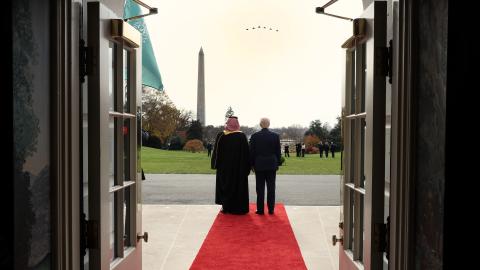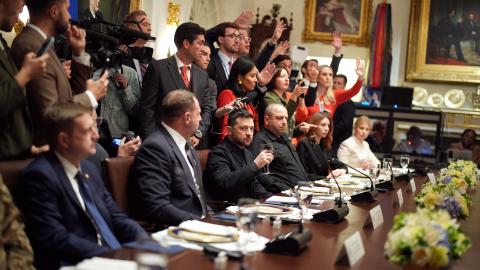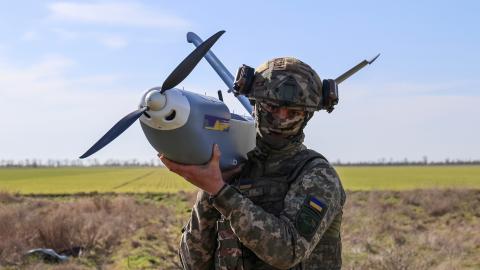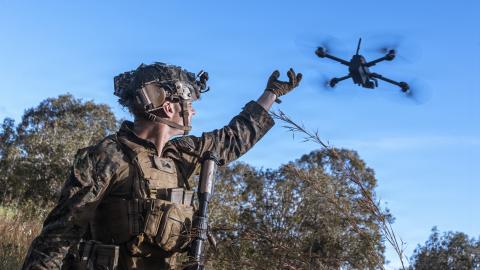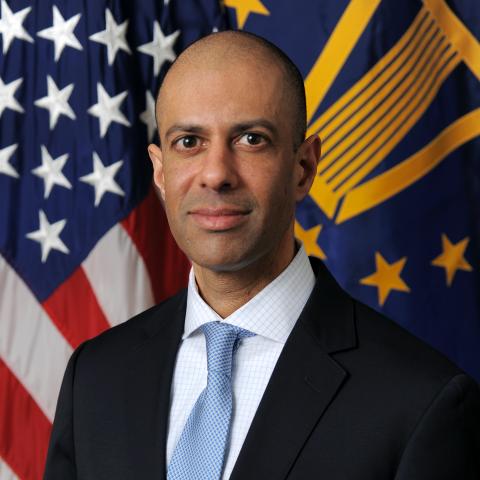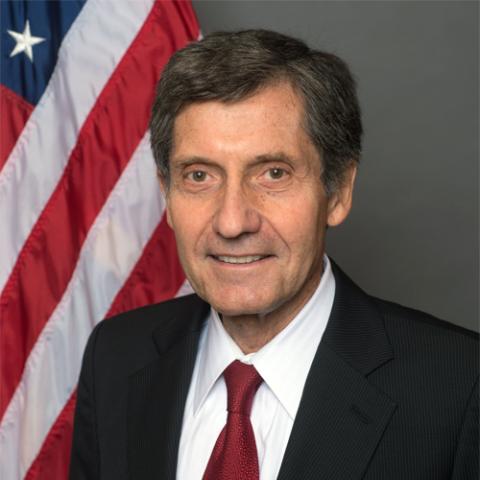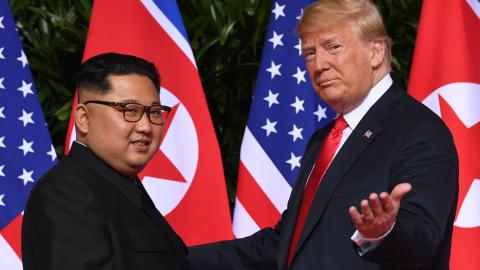Introduction: Scenarios for US-DPRK Reengagement
By Patrick M. Cronin
It is far easier for the United States to avoid direct diplomacy with North Korea than to chart a realistic path for high-level engagement that reduces risks. The United States and the Democratic People’s Republic of Korea (DPRK or North Korea) remain technically in a state of war nearly three-quarters of a century after the 1953 armistice. Prior to the first-ever summit between an American and North Korean leader, the prospects for diplomacy looked bleak. Yet the historic June 2018 meeting between Donald Trump and Kim Jong Un in Singapore briefly raised hopes for a new diplomatic framework. In the seven years since, US-DPRK relations have reverted to a familiar pattern of estrangement, widening considerably after the failed Hanoi summit in February 2019 and throughout President Joe Biden’s four-year term. Now, three developments have revived the possibility of renewed high-level diplomacy.
Reviving Diplomacy with Kim Jong Un
First, President Trump’s return to the White House has reignited speculation about a fresh attempt at reengagement with North Korea, including the potential resumption of summit diplomacy with Kim Jong Un. Since his second inauguration on January 20, 2025, President Trump has referred to North Korea as a “nuclear power,” a phrase that plays into the Kim regime’s quest for recognition as a permanent nuclear-weapon state. In a Fox News interview three days later, Trump signaled his intent to reconnect with Kim, calling him a “smart guy” and someone with whom he “got along.” This echoed comments he made before the November election, in which he touted his ability to de-escalate nuclear tensions and establish personal rapport with the North Korean leader. On March 13, Trump reiterated his “great relationship” during an Oval Office meeting with North Atlantic Treaty Organization (NATO) Secretary-General Mark Rutte. Later that month, he referred to North Korea as a “big nuclear nation” and declared that his administration was in “communication” with Kim.
A second development that seems to favor renewed US-DPRK diplomatic engagement is that North Korea has maintained a conspicuous silence toward Trump personally. Although the regime continues to rail against the United States, particularly its military exercises and missile defenses, it has avoided directly criticizing President Trump. Notably, Kim Yo-jong has issued no personal barbs, and Pyongyang has issued no formal rejection of Trump’s outreach. The regime did dampen expectations of a renewed Trump-Kim summit after the November election, but this could indicate a desire to hear more concrete overtures. By contrast, North Korea was consistently and caustically critical during the Biden years.
Finally, the June 3 election of a new South Korean president offers another potential inflection point. Under President Yoon Suk-yeol, North-South relations reached new lows. Kim Jong Un declared the South a “hostile state” and “principal enemy,” renounced peaceful unification, and razed symbols of inter-Korean ties. Yoon’s impeachment in December left policy adrift for six months. Now, however, the Lee Jae-myung administration has an opportunity to explore different avenues for engagement, even if Pyongyang currently appears more focused on deepening defense relations with Russia and maintaining economic support from China than on reengaging with either Seoul or Washington.
President Trump’s reengagement rhetoric has triggered a wave of predictable commentary in both the United States and South Korea, ranging from enthusiastic if cautious optimism to stark warnings. Some observers liken his outreach to that of other authoritarian leaders, including Vladimir Putin and Xi Jinping, to speculate a new chapter of “love letters” with Kim. Others cite Trump’s recent overtures to Iran and Syria as precedent for an unorthodox diplomatic gambit. Some commentators welcome the potential for renewed diplomacy. But some former officials warn against harboring illusions about a cooperative or concessionary DPRK. Still others have called for a much sharper response to North Korea’s perpetual provocations and threats.
In anticipation of these renewed possibilities, Hudson Institute and the Chey Institute for Advanced Studies convened this joint study to assess diplomatic options for reengaging North Korea. We envisioned developing a range of scenarios that could unfold and hope they will also help inform the new South Korean government regarding implications for the US-ROK relations, inter-Korean ties, and regional security. This report emphasizes the former: i.e., alternative pathways for renewed high-level US-DPRK diplomacy. The six essays that follow provide a spectrum of perspectives on the scope, timing, and terms under which the Trump administration might pursue dialogue, high-level meetings, or a broader diplomatic process. These essays do not ignore the many reasons for skepticism: North Korea’s entrenched, dynastic authoritarianism; human rights abuses; illicit and malign economic and cyber activities; material support for Russia’s war in Ukraine; and its unrelenting nuclear and missile buildup. Yet all contributors agree that diplomacy remains essential for managing risks posed by a nuclear-armed North Korea. Where they differ, however, is on what diplomats should aim to achieve and how they should proceed.
Alternate Views: Summarizing the Essays
The following six essays reflect a diverse range of views on how the Trump administration might pursue renewed diplomacy with North Korea. While all contributors support engaging a nuclear-armed DPRK, they differ significantly in their assumptions, priorities, and prescriptions.
Frank Aum advocates for a pragmatic approach focused on “stable coexistence,” building on the 2018 Singapore summit joint statement. He proposes an interim agreement centered on reciprocal tension-reduction steps: scaling back US-ROK military exercises and deployments of “strategic assets” as North Korea freezes its nuclear and long-range missile tests. Aum recommends trading sectoral sanctions relief covering textiles, seafood, coal, and minerals, for dismantling the Yongbyon nuclear complex. Rather than insist on immediate denuclearization, he suggests deferring it as a long-term aspiration, akin to commitments under the Nuclear Nonproliferation Treaty (NPT). Aum also proposes a dramatic political gesture, such as an end-of-war declaration at a four-party summit with China and South Korea. He encourages Seoul’s new leadership to move beyond the August 15, 2024, unification policy, which has been criticized by some as resembling “unification by absorption.” He also assesses President Trump as uniquely capable of resetting bilateral ties in ways future US administrations may struggle to undo.
Jenny Town, like Aum, prioritizes political normalization over denuclearization, arguing that a lasting solution begins by ending the Korean War and establishing formal diplomatic recognition. She urges a sober reassessment of North Korea’s durability and strategic value to Moscow and Beijing, warning that the peninsula’s security dilemmas cannot be resolved in isolation from wider geopolitical trends. Town recommends discarding past frameworks built on coercive pressure, military buildups, and cautious diplomacy. Instead, she calls for a diplomatic reset that addresses the political relationship first. Town also contends that a new political relationship can lay the foundation for future arms control and regional stability.
Keith Luse argues for stable coexistence but emphasizes the potential utility of the personal rapport between Trump and Kim. He proposes institutionalizing quarterly high-level leader engagements as a foundation for an eventual peace declaration and renewed denuclearization talks. Luse sees the unique dynamics between Trump and Kim as a rare diplomatic asset that, if nurtured carefully, could lead to reciprocal visits to Pyongyang and the White House. In the end, Luse believes these symbolic shows of goodwill can usher in a true normalization of relations that he thinks is long overdue.
Joseph DeTrani, drawing on his experience as a US negotiator with North Korea, calls for a prudent action-for-action approach reminiscent of the 2005 Six Party Talks. He urges a recalibrated version of the Hanoi summit that ended without any agreement. DeTrani recommends phased steps in which sanctions relief is exchanged for halting fissile material production, ballistic missile tests, and nuclear activities. He argues that normalization and sanctions relief remain the most powerful levers of US influence over Kim. Even so, DeTrani cautions that the process of diplomatic engagement with North Korea will be slow and uncertain.
Doug Bandow offers a realistic perspective aimed at containing the largest threats at minimal cost and maximum restraint. He argues that North Korea should be accepted as a de facto nuclear weapons state, and the United States should recalibrate its goals accordingly. Bandow contends that denuclearization is unrealistic and that containment and deterrence, anchored in arms control and threat reduction, should be the near-term priorities. He even suggests that if South Korea feels inadequately protected under the current extended deterrence framework, developing an independent nuclear capability may prove more credible than relying on US nuclear guarantees.
Vipin Narang is the most skeptical of the group. He emphasizes the twin goals of deterrence and nonproliferation as the essential goals that should guide US policy. Narang argues that US policy should focus on preventing nuclear use by North Korea and forestalling South Korea’s potential pursuit of an independent nuclear arsenal. He warns against a desperation for deals at a time when the United States has lost the meaningful leverage it had in 2017. He calls for rebuilding US and allied deterrence capabilities, including shoring up extended deterrence to help prevent North Korea’s use of a tactical nuclear strike. He supports further development of a sea-based tactical nuclear capability (SLCM-N), but he warns against deploying highly vulnerable B61 nuclear warheads to South Korea. Narang also advocates for strengthening extended deterrence through nascent institutions like the US-ROK Nuclear Consultative Group. He believes the alliance can be deepened through shared responsibility, enhanced burden-sharing, and recommitment to nonproliferation norms.
Five Tradeoffs or Strategic Dilemmas
The diverse proposals in this volume illuminate several recurring tradeoffs that have long confounded US policy on North Korea. These strategic dilemmas are likely to shape the contours of diplomacy in the coming years, and certainly the calculations of the Trump administration as it considers renewed high-level engagement with the Kim regime.
- Peace vs. Denuclearization. The first strategic dilemma is whether the United States objective vis-à-vis North Korea should be peace and political stability or denuclearization. Diplomatic efforts dating back to the 1994 Agreed Framework, running through the 2005 Six Party Talks joint statement, emerging in the short-lived “Leap Day” deal in February 2012, and threaded through the Singapore summit in 2018 all focused on the seemingly implausible objective of complete, verifiable, and irreversible dismantlement (CVID) of Pyongyang’s nuclear program. Of course, peace versus denuclearization can also be considered a false choice. As North Korea has built up its nuclear arsenal and demonstrated its unwillingness to relinquish it, the goal of denuclearization has increasingly shifted toward becoming a longer-term objective, an end goal at the end terminus of a long process. But as the essays in this study make clear, there is an apparent fundamental tradeoff in prioritizing either a political peace or a reduction in the North Korean nuclear threat.
- Containment vs. Disarmament. Another way to think about an important tradeoff is to juxtapose containment of the North Korean threat with arms control and disarmament. Freezing current arrangements is easier than compelling an adversary to roll back its capabilities. That is why some see containment as a more realistic goal than denuclearization and arms control. Others, however, think containing the problem requires positive alliance actions to keep enhancing deterrence. Still others think engagement, not containment, is essential for eventually finding a pathway for disarmament. Indeed, the essays in this report sketch out a range of competing diplomatic philosophies: containment and threat management; incremental, phased agreements; personal leader-to-leader diplomacy; normalization of diplomatic ties and peace as a foundation for reducing threats; and strengthening national and alliance leverage before attempting negotiations.
- Symbolism vs. Substance. A third tradeoff is whether to focus on or settle for atmospherics and symbolic shows or insist on substantive, meaningful measures to reduce tensions or advance mutually beneficial connections. There is a consensus that President Trump and Chairman Kim prize personal diplomacy and generally have a positive rapport. However, there is also an abiding concern that summit atmospherics can complicate or downplay serious disagreements. Personal diplomacy can be an essential icebreaker, but it can also make a poor and unsustainable substitute for deliberate, binding agreements.
- Cautious Diplomacy vs. Bold Diplomacy. Experience suggests baby steps are easier than grand bargains, but the same record shows baby steps appear unsustainable without a transformed political environment. That is why essays in this volume emphasize either a bold attempt to transform the political relationship between the United States and North Korea, on the one hand, or cautious, step-by-step diplomacy to determine whether any meaningful progress in relations is achievable.
- North Korea vs. Regional Geopolitics. A final strategic dilemma is whether to concentrate on improving bilateral ties with North Korea or link progress to wider geopolitical competition and relations. All authors agree on South Korea’s vital role. But there is some difference of view as to whether China, Russia, and Japan need to be part of future diplomacy and agreements. But can any serious US-DPRK rapprochement occur without provoking a strategic countermove from Beijing and Moscow? That move could be to support the United States if it seems to be departing the peninsula; more likely, their move may be to block any gains in American influence on the peninsula. Similarly, if the United States were to strike a “small deal” that minimizes intercontinental ballistic missile (ICBM) threats to the United States but leaves intact North Korea’s missile threats to South Korea and Japan, wouldn’t such a narrow accord simply transfer the security dilemmas on to US allies?
All authors agree North Korea poses a growing challenge, but their solutions diverge on timing, leverage, sequencing, and political assumptions. Those favoring diplomacy emphasize phased engagement; others prioritize strategic patience, deterrence, and alliance cohesion. These essays are not meant to advocate making ill-conceived deals with North Korea. But they underscore that every approach carries implications: strategic, political, and moral. Understanding and responding to these and other tradeoffs will be crucial for avoiding past pitfalls and achieving a more stable and secure Korean Peninsula.

